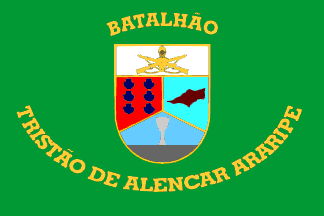 image by Joseph McMillan
image by Joseph McMillan
Last modified: 2011-06-03 by ian macdonald
Keywords: brazil | regiment | battalion |
Links: FOTW homepage |
search |
disclaimer and copyright |
write us |
mirrors
All the grants of unit standards made in the last ten years follow a standard pattern. For combat units identified with a particular arm of service (battalions, squadrons, groups, batteries, companies, regiments, brigades, divisions), the field is solid in the color of the arm of service:
Unless otherwise noted, the sources for all of these are the descriptions and illustrations of the flags at
http://www.sgex.eb.mil.br/CDocEx/descricao_heraldica_e_figura_dos.htm . The descriptions provided are condensed translations
of the official descriptions.
Joseph McMillan, 20 June 2001
Green field, the color of the infantry. On the center a Portuguese shield edged and trimmed in gold: the
chief white with
the symbol of the armored infantry in gold [two crossed rifles surmounted by a knight's helmet]; first field
[first quarter] red with six blue scallop shells, from the arms of the family of Alencar Araripe; second
field [second quarter] light blue [azul-claro] with a replica in brown of the island of Fernando Noronha,
a strategic point occupied in World War II
by a detachment commanded by Colonel Alencar Araripe, who was also governor of the island; third field [base]
sky-blue [bleu-celeste]
with a stylized silver cup, representing the stone "cup" carved by the wind in the Vila Velha state park,
the symbol of the city of
Ponta Grossa, seat of the 13° BIB. Surrounding the shield the historic designation,
Batalhão Tristão de
Alencar Araripe in gold. Approved by Ministerial Order 831, 29 December 1998.
Joseph McMillan, 20 June 2001
White field, the color of the cavalry. On the center a sky-blue [azul-celeste] Portuguese shield,
edged in red,
superimposed on two golden crossed lances. In chief, a Phrygian cap in red; in the center, two crossed
silver swords, charged with the numeral "9"
and surrounded by a laurel wreath, all in gold. Above the device the historic designation Regimento
Solon Ribeiro in gold.
Approved by Ministerial Order 466, 16 May 1988.
Joseph McMillan, 20 June 2001
Ultramarine blue [azul-ultramar] field, the color of the artillery. On the center, a Portuguese shield
edged and
trimmed in gold: the chief white with the symbol of the artillery [a flaming grenade] in black and red;
the first field silver with a red lion
rampant, from the arms of the family of Queiroz, in remembrance of Antônio de Queiroz Telles, Baron
of Jundiahy; the second field
green with a white fortress surmounting a red cogwheel, elements contained in the flag of the municipality
of Jundiaí;
the third field [base] sky-blue [azul-celeste] with three stylized black fishes, representing the
jundiá,
the characteristic fish of the hydrographic basin of the region from which the name of the city where the
group has its headquarters is derived.
Above the shield a baron's coronet, and surrounding the whole the historic designation Grupo Barão
de Jundiahy in gold.
Approved by Ministerial Order 666, 16 October 1998.
Joseph McMillan, 20 June 2001
Sky blue (the branch color of communications) with the unit coat of arms on the center,
superimposed on
two red lightning flashes in saltire, and the "historic designation" of the
unit in gold letters.
Joseph McMillan, 11 February 2002
There are a number of these Army-sponsored
military secondary schools. All use the same pattern of standard, light blue with a
saltire in the national colors of yellow and green, with a red star on the
center bordered in silver and with a tower in silver superimposed. Above and below
the star are arcs with the words Colégio Militar. At the bottom (not shown on
the illustration) would be the name of the city where the particular school is located.
Joseph McMillan, 11 February 2002